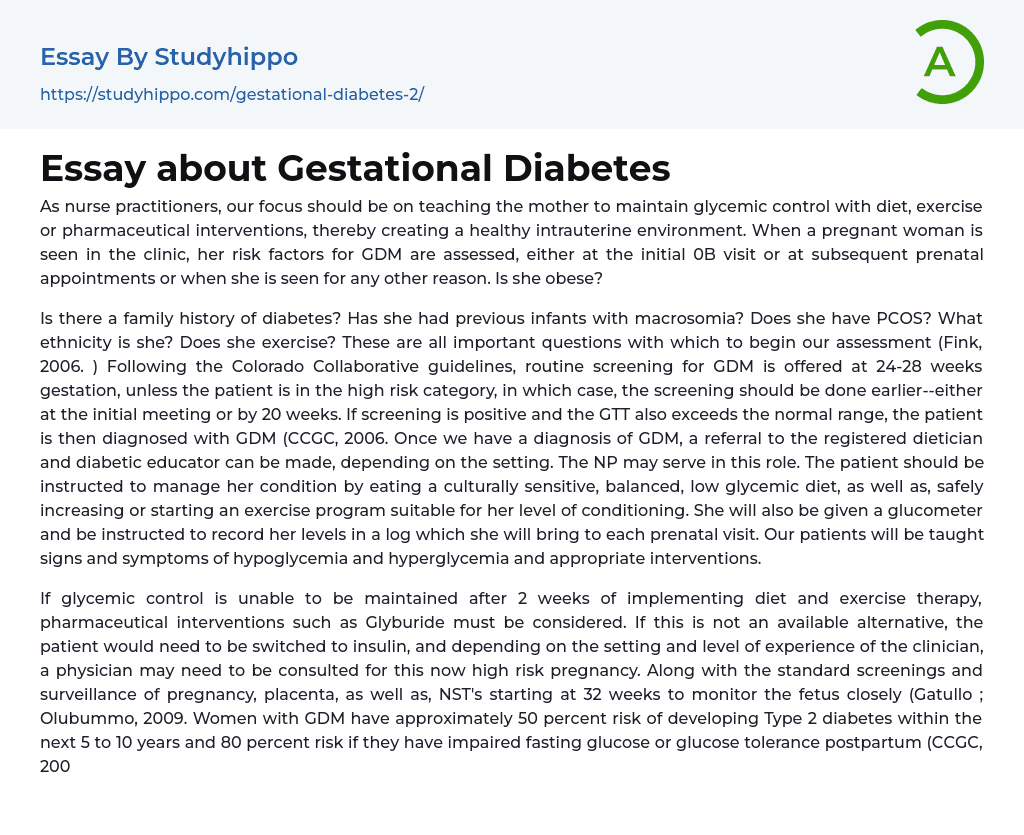As nurse practitioners, our primary goal is to educate mothers about the significance of maintaining glycemic control while pregnant. We employ a range of techniques including diet, exercise, and medications to establish a healthy intrauterine environment. During evaluations at our clinic, we assess pregnant women for risk factors associated with Gestational Diabetes Mellitus (GDM). This evaluation takes place during their first OB visit, subsequent prenatal appointments, or any other visit. One important factor we take into account is obesity in women.
The assessment begins by asking several important questions regarding the patient's family history of diabetes, previous occurrences of infants with macrosomia, PCOS, ethnicity, and exercise habits (Fink, 2006). According to the Colorado Collaborative guidelines, routine screening for GDM is typically done at 24-28 weeks gestation. However, if the patient is con
...sidered high risk, screening should be performed earlier, either during the initial meeting or by 20 weeks. A positive screening result along with an abnormal GTT confirms the diagnosis of GDM (CCGC, 2006). Once diagnosed, the patient may be referred to a registered dietician and diabetic educator, or the NP may fulfill this role. The patient will receive instructions on managing her condition through a culturally sensitive, balanced, low glycemic diet and an appropriate exercise program. Additionally, she will be provided with a glucometer and instructed to record her glucose levels in a log to bring to each prenatal visit. Education on identifying signs and symptoms of hypoglycemia and hyperglycemia and appropriate interventions will also be provided.
If glycemic control cannot be achieved through diet and exercise therapy for two weeks, the consideration of pharmaceutical interventions such as Glyburide is necessary. If this
option is not available, switching the patient to insulin may be required. For high-risk pregnancies like this, consultation with a physician may be required, depending on the setting and clinician's experience level. Close monitoring of the fetus should begin at 32 weeks using placental and NST tests in addition to standard pregnancy screenings and surveillance (Gatullo ; Olubummo, 2009). Women with GDM have a 50 percent risk of developing Type 2 diabetes within 5 to 10 years. This risk increases to 80 percent if they have impaired fasting glucose or glucose tolerance postpartum (CCGC, 2006). Hence, it is crucial for the patient to return for postpartum follow-up visits within 6-12 weeks for necessary testing and education. Continuing breastfeeding is encouraged as it benefits both the baby and aids in weight loss for mothers.
Our responsibility as Nurse Practitioners is to help patients reduce the risk of diabetes by promoting healthy eating habits and exercise routines. It is recommended that patients undergo annual screenings and receive preconception care if they plan on having another child. When caring for gestational diabetic patients, NPs can provide comprehensive counseling and support that considers the well-being of both women and their babies in the short term and long term. Research suggests that NPs have potential to expand their role in Centeringpregnancy, which has been linked to improved outcomes in high-risk populations. Patients who participate in group care tend to be more engaged, satisfied, and form connections with others. This approach may benefit our GDM patients by creating a safe environment for learning, exchanging thoughts, and expressing emotions.
- Type 2 Diabetes essays
- Hospital essays
- Physician essays
- Health Care Provider essays
- Universal Health Care essays
- Readmission essays
- Social Care essays
- Epidemiology essays
- Drug Addiction essays
- Hiv essays
- Hygiene essays
- Obesity essays
- Teenage Pregnancy essays
- Birth Control essays
- Eating Disorders essays
- Causes Of Obesity essays
- Children Obesity essays
- Apoptosis essays
- Asthma essays
- Black Death essays
- Breast Cancer essays
- Cholesterol essays
- Chronic essays
- Chronic Pain essays
- Death essays
- Diabetes essays
- Down Syndrome essays
- Epidemic essays
- Hypertension essays
- Infection essays
- Infertility essays
- Myocardial Infarction essays
- Pain essays
- Pathogen essays
- Pregnancy essays
- Sexually Transmitted Disease essays
- Symptom essays
- Tuskegee Syphilis Experiment essays
- Water supply essays
- Addiction essays
- Anatomy and Physiology essays
- Biodegradation essays
- Cancer essays
- Dental Care essays
- Disability essays
- Disease essays
- Disorders essays
- Health Care essays
- Infectious Disease essays
- Inquiry essays




